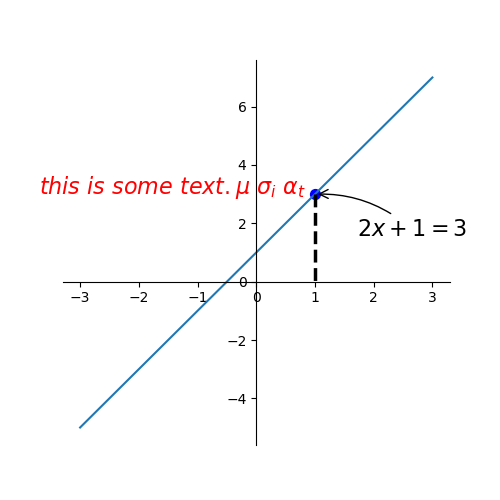import numpy from matplotlib import pyplot x=numpy.linspace(-3,3,50) y=2*x+1 pyplot.figure(num=1,figsize=(5,5)) pyplot.plot(x,y) ax=pyplot.gca() ax.sp ...
import numpy from matplotlib import pyplot x=numpy.linspace(-3,3,50) y=2*x+1 pyplot.figure(num=1,figsize=(5,5)) pyplot.plot(x,y) ax=pyplot.gca() ax.spines['right'].set_color('none') ax.spines['top'].set_color('none') ax.xaxis.set_ticks_position('bottom') ax.spines['bottom'].set_position(('data',0)) ax.yaxis.set_ticks_position('left') ax.spines['left'].set_position(('data',0)) x0=1 y0=2*x0+1 pyplot.scatter(x0,y0,s=50,color='b') #在直線上顯示一個點,s指點的面積大小,color指點的顏色 pyplot.plot([x0,x0],[y0,0],'k--',lw=2.5) #方法一 pyplot.annotate(r'$2x+1=%s$'%y0,xy=(x0,y0),xycoords='data',xytext=(+30,-30),textcoords='offset points',fontsize=16,arrowprops=dict(arrowstyle='->',connectionstyle='arc3,rad=.2')) #方法二 pyplot.text(-3.7,3,r'$this\ is\ some\ text. \mu\ \sigma_i\ \alpha_t$',fontdict={'size':16,'color':'r'}) pyplot.show()




